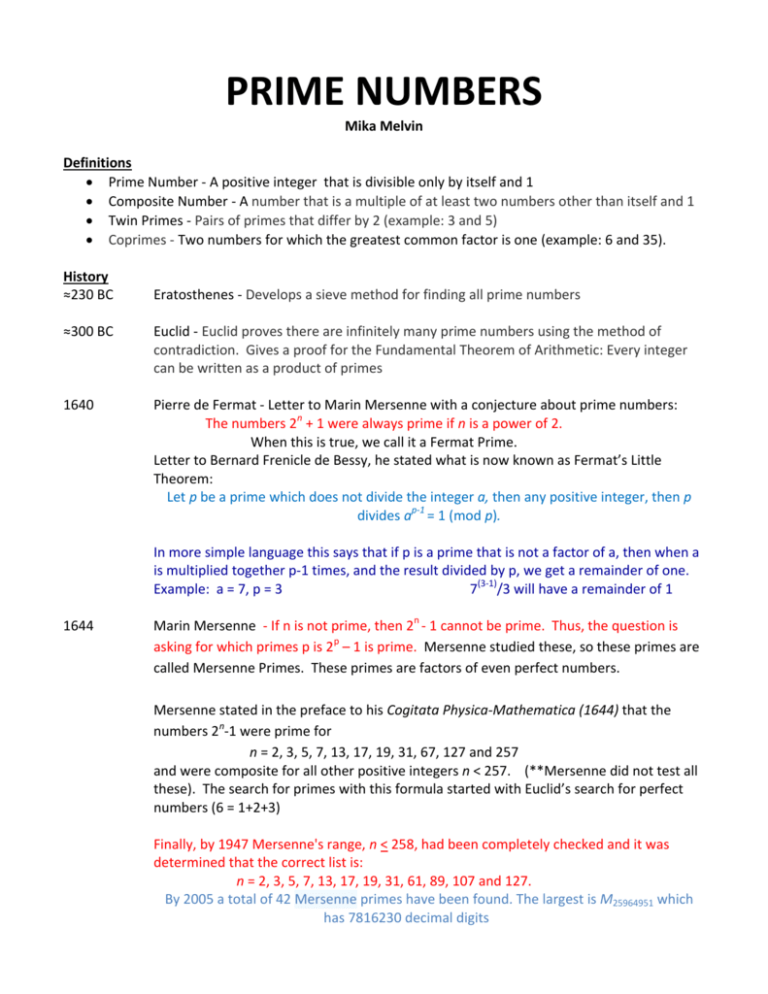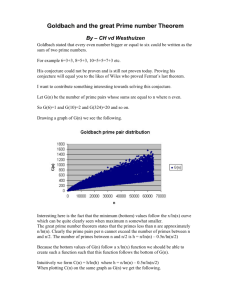prime numbers - Mathematical & Statistical Sciences
advertisement

PRIME NUMBERS Mika Melvin Definitions Prime Number - A positive integer that is divisible only by itself and 1 Composite Number - A number that is a multiple of at least two numbers other than itself and 1 Twin Primes - Pairs of primes that differ by 2 (example: 3 and 5) Coprimes - Two numbers for which the greatest common factor is one (example: 6 and 35). History ≈230 BC Eratosthenes - Develops a sieve method for finding all prime numbers ≈300 BC Euclid - Euclid proves there are infinitely many prime numbers using the method of contradiction. Gives a proof for the Fundamental Theorem of Arithmetic: Every integer can be written as a product of primes 1640 Pierre de Fermat - Letter to Marin Mersenne with a conjecture about prime numbers: The numbers 2n + 1 were always prime if n is a power of 2. When this is true, we call it a Fermat Prime. Letter to Bernard Frenicle de Bessy, he stated what is now known as Fermat’s Little Theorem: Let p be a prime which does not divide the integer a, then any positive integer, then p divides ap-1 = 1 (mod p). In more simple language this says that if p is a prime that is not a factor of a, then when a is multiplied together p-1 times, and the result divided by p, we get a remainder of one. Example: a = 7, p = 3 7(3-1)/3 will have a remainder of 1 1644 Marin Mersenne - If n is not prime, then 2n - 1 cannot be prime. Thus, the question is asking for which primes p is 2p – 1 is prime. Mersenne studied these, so these primes are called Mersenne Primes. These primes are factors of even perfect numbers. Mersenne stated in the preface to his Cogitata Physica-Mathematica (1644) that the numbers 2n-1 were prime for n = 2, 3, 5, 7, 13, 17, 19, 31, 67, 127 and 257 and were composite for all other positive integers n < 257. (**Mersenne did not test all these). The search for primes with this formula started with Euclid’s search for perfect numbers (6 = 1+2+3) Finally, by 1947 Mersenne's range, n < 258, had been completely checked and it was determined that the correct list is: n = 2, 3, 5, 7, 13, 17, 19, 31, 61, 89, 107 and 127. By 2005 a total of 42 Mersenne primes have been found. The largest is M25964951 which has 7816230 decimal digits 1730 - 1750 Leonhard Euler - Discovered that 641 was a factor of 22^5 + 1, thus showing that not all numbers derived from Fermat’s conjecture are prime. Verified that 231 – 1 was prime (Mersenne prime) Published a proof of Fermat’s Little Theorem and extended it: If P is a prime, then for any number a, ( aP - a ) must be divisible by P. Euler φ-function is defined as the number of positive integers between 1 and n-1 that are relatively prime (or coprime) to n 1750 - 1850 Gauss and Legendre - Attempted to calculate the density of primes. Gauss’ estimation of 1/log(n) is known as the Prime Number Theorem. This theorem was proved independently in 1896 by Hadamard and de la Vallée Poussin 1859 Georg Riemann - Published paper with conjecture that the frequency of prime numbers is closely related to the behavior of the reimann zeta function. The reimann hypothesis states that all non-trivial zeros of the reimann zeta function have real part one-half, so they all lie on a specific vertical line in the complex plane. There is no proof or disproof yet. **1.5 billion zeros have been checked and satisfy his hypothesis. The closer the real part of the zeros to ½, the more regular the distribution of the primes. So, if the prime number theorem tells us something about the distribution of the primes along the number line, then the Riemann hypothesis tells us something about the deviation from the average. 1900s Goldbach – Every even integer can be written as a sum of 2 primes Landau – presented four “Unattackable” problems about primes (yet to be solved) Goldbach's conjecture: Can every even integer greater than 2 be written as the sum of two primes? Twin prime conjecture: Are there infinitely many primes p such that p + 2 is prime? Legendre's conjecture: Does there always exist at least one prime between consecutive perfect squares? Are there infinitely many primes p such that p − 1 is a perfect square? In other words: Are there infinitely many primes of the form n2 + 1? Gaussian – Gaussian primes are prime complex numbers Twin primes – Are there an infinite number? Communication with aliens – developed by frank drake and Carl Sagan GIMPS – The great internet mersennes prime search was launched in 1996 by George Woltman. Is ONE a prime number? One is NOT considered a prime number. The definition for prime number states that a prime number must be divisible by itself AND 1. One only has one divisor, so cannot be prime. WHY do people care? Money and Mystery Practical application for RSA Encryption (Based on factoring large numbers into 2 problems, which would take a very long time if you don’t know the 2 primes used!) Did only Western Math develop prime numbers? First, I would suggest that prime numbers are discovered, not developed! There is some debate about the Chinese Hypothesis that states an integer n is prime if 2n-2 is divisible by n. This hypothesis is commonly attribute to Chinese from around the time of Confucius (551 – 479 BC), but this is refuted as a translation error and the hypothesis is attributed to Li Shan-Lan (1811-1882). Class Activites Use the Sieve of Eratosthenes to find prime numbers Use primes to factor larger numbers Other Questions What is the importance of Gaussian primes? Besides cicadas, are there animal behaviors/structures that use primes? A proof or disproof of Riemann’s hypothesis is worth $1 million as part of the Clay Millennium Prize Problems. There are prizes for the largest prime numbers found. "Because both the system's privacy and the security of digital money depend on encryption, a breakthrough in mathematics or computer science that defeats the cryptographic system could be a disaster. The obvious mathematical breakthrough would be the development of an easy way to factor large prime numbers" Bill Gates The largest prime number is 12,978,189 digits long. It is the largest of the 47 known Mersenne primes as of June 2009 The Sieve of Erasothenes REFERENCES Ask Dr. Math. Accessed at http://mathforum.org/dr.math/ Cabillon, Julio. Fermat’s Little Theorem. Accessed at http://www.pballew.net/FermLit.html Caldwell, Chris. The Prime Glossary. 2010. Accessed at http://primes.utm.edu/glossary/home.php Clay Mathematics Institute. Accessed at http://www.claymath.org/millennium/Riemann_Hypothesis/1859_manuscript/ Derbyshire, John. Prime Obsession. 2004. Accessed at http://www.amazon.com/exec/obidos/tg/detail/-/0309085497/103-4727041-3727061?v=glance Katz, Victor J. A History of Mathematics: An Introduction. HarperCollins College Publishers. 1993 O'Connor, J J and E F Robertson. Prime number. (May 2009). Accessed at http://www-history.mcs.stand.ac.uk/HistTopics/Prime_numbers.html Pomerance, Carl. Prime Numbers and the Search for Extraterrestrial Intelligence. Accessed at http://www.math.dartmouth.edu/~carlp/PDF/extraterrestrial.pdf prime number. (n.d.). Dictionary.com Unabridged. Retrieved June 10, 2010, from Dictionary.com website: http://dictionary.reference.com/browse/prime number prime number. (n.d.). The American Heritage® Dictionary of the English Language, Fourth Edition. Retrieved June 10, 2010, from Dictionary.com website: http://dictionary.reference.com/browse/prime number Ribenboim, Paulo. The New Book of Prime Number Records. 1988. Stankova-Frenkel, Zvezdelina. RSA Encryption. 2000. Accessed at http://mathcircle.berkeley.edu/BMC3/rsa/node4.html Su, Francis E., et al. "Fermat's Little Theorem." Mudd Math Fun Facts. http://www.math.hmc.edu/funfacts Weisstein, Eric W. "Chinese Hypothesis." From MathWorld--A Wolfram Web Resource. http://mathworld.wolfram.com/ChineseHypothesis.html









